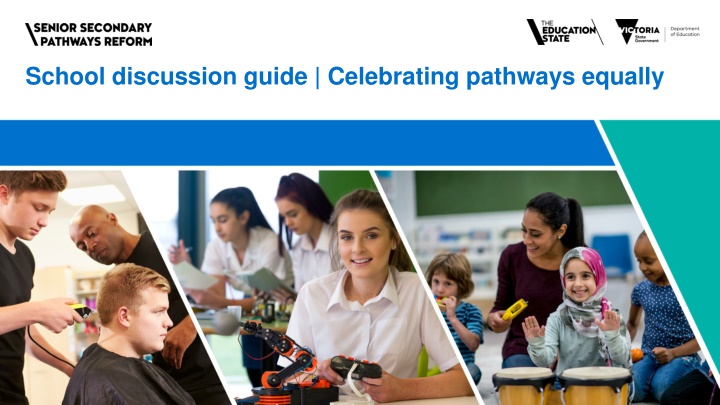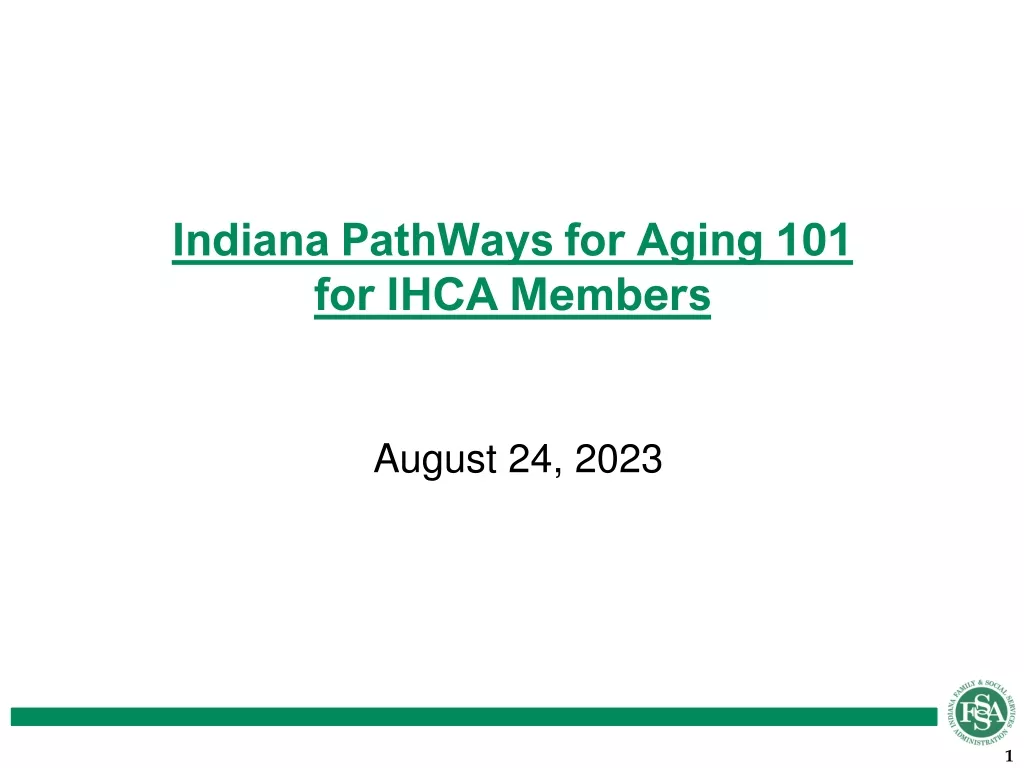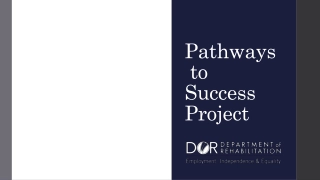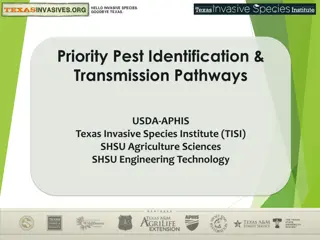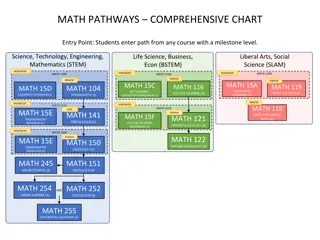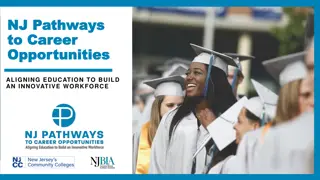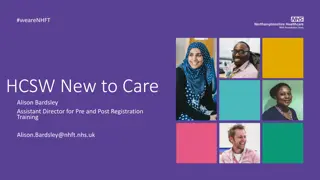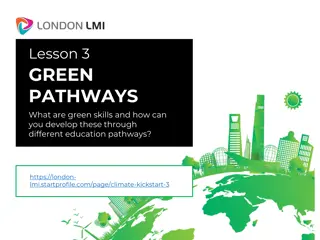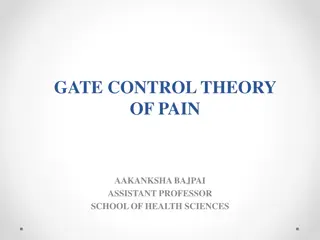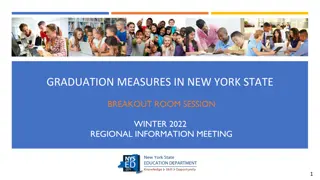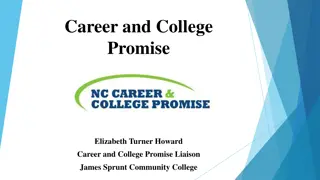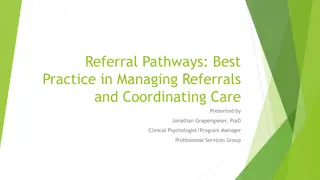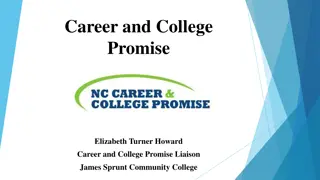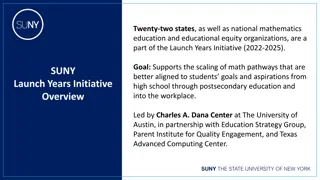School discussion guide | Celebrating pathways equally
Explore a comprehensive discussion guide focused on celebrating student pathways equally in Victorian schools. The guide outlines five key principles and four opportunities for equal celebration, emphasizing student motivation, unity, and partnership. Learn to adapt the slides to your school's priorities and engage in meaningful staff discussions on the importance of diverse student achievements.
Download Presentation

Please find below an Image/Link to download the presentation.
The content on the website is provided AS IS for your information and personal use only. It may not be sold, licensed, or shared on other websites without obtaining consent from the author.If you encounter any issues during the download, it is possible that the publisher has removed the file from their server.
You are allowed to download the files provided on this website for personal or commercial use, subject to the condition that they are used lawfully. All files are the property of their respective owners.
The content on the website is provided AS IS for your information and personal use only. It may not be sold, licensed, or shared on other websites without obtaining consent from the author.
E N D
Presentation Transcript
Using these slides to lead a staff discussion about celebration Victorian schools have many varied and excellent approaches to celebrating students. As a school leader, you can use these presentation slides to guide a reflective staff discussion about your school s approach to celebrating programs and students, focused on: Five principles for equal celebration: 1. Student motivation 2. Student parity 3. Student unity 4. Frequency 5. Partnership Four opportunities for equal celebration: 1. Documenting success 2. Communication 3. Student recognition 4. Student leadership The principles and opportunities were developed by researching existing school approaches and consulting with school leaders and partners. The Policy and Advisory Library also has a reflective checklist your staff can use to consider the principles and opportunities. 2
Adapt these slides to your schools priorities This discussion guide includes: Slides 2-3: How to use this resource Slides 5-6: Why equal celebration matters Slides 7-8: Principles and opportunities for equal celebration Slides 9-14: The principles in detail Slides 15-20: The opportunities in detail You re welcome to skip or amend slides for your discussion. In your discussion, using examples specific to your school will make the content more engaging and relevant. You may also like to connect this to other frameworks relevant to your school, including: Your school improvement plan, or FISO 2.0 generally High Impact Teaching Strategies School Positive Wellbeing and Behaviour Supports. 3
Slides for presentation 4
Equal celebration for equal achievement We work hard to celebrate our students. But only 27% of Victorians (and 32% of secondary school staff and senior secondary students surveyed*) think all senior secondary education pathways in schools are celebrated equally. Celebration is about more than awards. It can include: - how we present our learning program to our community and the public - how we talk about pathway options and students - students opportunities for leadership. Do we celebrate all pathways equally? Let s discuss. *Senior Secondary Education Perceptions Research, Department of Education, 2023 5
Our students learning and achievement is becoming more diverse The role of vocational and applied learning in Victorian schools is expanding: - Delivery of the VCE Vocational Major is growing - VET enrolment is growing - Career practitioners are encouraging students to explore a wide variety of pathways - The Victorian Pathways Certificate is being delivered - Head Start is available in all government schools Students should see that all forms of learning and achievement are worthy of celebration. 6
Five principles for equal celebration When looking at how to celebrate student pathways equally, we can consider: 1. Student motivation By focusing on students goals when celebrating their achievements, we prevent stigma 2. Student parity By giving all learning programs equal visibility and emphasis in our school, we prevent bias in pathway selection 3. Student unity By treating students in all programs as parts of one cohort, we strengthen our school community 4. Partnership By working with our VET providers and cluster, community, employers and Head Start, we identify and celebrate all forms of achievement 5. Frequency By regularly celebrating achievements of all sizes, we foster respect and self-belief 7
Four opportunities for equal celebration We can apply the guiding principles through: 1. Documenting success How we make informed decisions about school-based and external achievement, beyond competent/completed 2. Communication How and when we talk about our programs and students 3. Student recognition How and when we celebrate awards, at school and beyond 4. Student leadership How we involve and elevate current and former students 8
Principles for equal celebration 9
Principle 1: Student motivation By focusing on a student s choices and goals when celebrating achievement, we prevent stigma. We can talk about the same student s achievement in different ways. When we focus on previous challenges, we can stigmatise a program or learning. Consider how these different words of celebration might be heard by Dominic and his peers: Dom has come a long way! Thank goodness for the VCE Vocational Major. He s so engaged and focused now, and doing so well. He s overcome a lot of challenges, and we couldn t be prouder of him. Dom is setting himself up for success! His passion for technology shows in his work. He s so engaged and focused, and doing so well. He s set his sights on a fantastic career in information technology, and we couldn t be prouder of him. For discussion: How can we make sure the focus of our celebration is on students goals? 10
Principle 2: Student parity By giving all learning programs equal visibility and emphasis in our school, we motivate students to choose an appropriate pathway. Equal visibility of students and achievements in various programs encourages familiarity. This fosters an appreciation for different forms of learning, and the role of different programs in our school s culture and educational program. Equal emphasis on different learning programs and achievement means different pathways are perceived as equally positive. This prevents bias in student pathway selection, meaning students feel free to choose a senior secondary pathway that suits their goals. How can we balance our emphasis on scored and non-scored achievement? Are all senior secondary pathways equally visible in our school? 11
Principle 3: Student unity By treating students in all programs as parts of one cohort, we strengthen our school community. VCE Vocational Major students are VCE students. VPC students should feel included among their VCE student peers. Any student can include VET as part of their senior secondary program. As much as it is important for these programs and students to be visible, it s also important for them to feel like parts of their peer cohort. This supports student wellbeing, and prevents stigma and bias. Do we celebrate our VCE Vocational Major as VCE students? How do we balance student unity and visibility in our school? 12
Principle 4: Frequency By celebrating achievements often, we foster respect and self-belief. In front of small groups, frequent celebration builds expectation among receiving and observing students that their work is worthy of celebration. It also provides evidence to justify major celebration later. In front of large groups, frequent celebration motivates students to succeed, while supporting the principles of student motivation and parity. BUT: We need to be mindful to avoid inauthentic or token celebration, which students will sniff out easily, and can create stigma. We prevent this by making celebrations credible for example, through clear reasoning and fairness, and external partner support. Is celebration a consistent or regular part of all our learning programs? 13
Principle 5: Partnership By working with our VET providers and cluster, community, employers and Head Start, we identify and celebrate all students achievements. Vocational and applied learning often happens outside the school context. This means we need to communicate with our partners to identify achievements deserving celebration. We can also involve our partners in how we celebrate students, who can lend their credibility and enthusiasm. Are we communicating with our partners about student excellence? Are we including our partners in our student celebrations? 14
Opportunities for equal celebration 15
Key principles: 2. Student parity 4. Partnership Documenting success We can make informed decisions about school-based and external achievement, beyond competent/completed. This helps us explain why a student is being celebrated. We can collect information about excellence and achievement on/from: School-based learning External VET partners Community project and work- based learning partners Recording when students go above and beyond Contacting VET providers to understand the nuance behind competency reports Achievement and impact in projects, structured work- based learning, or Head Start Do we have the information to make credible decisions about student awards? 16
Key principles: 2. Student parity 5. Frequency Communication We can celebrate equally in where, when and how we highlight programs and achievements. We can do this by giving equal visibility and emphasis to all learning programs, including in our: Staff and student communication Family communication Website presence What we highlight (and how often) in our newsletter, social media, messages to families, parent council meetings, and events The forms of learning and achievement we display in photos, and how easy it is to find information on pathways What we talk about when we get together How can our school give visibility and emphasis to students diverse achievements? 17
Key principles: 1. Student motivation 2. Student parity Student recognition We can celebrate students equally in awards and celebrations, at school and beyond. When we celebrate any form of learning, a focus on students goals and choices can prevent unintended stigma. Evidence from assessments and partners helps us choose and communicate. There are many ways equality of visibility and emphasis can be achieved, including: Mirroring score-based awards Mirroring score-based displays Taking note of how we celebrate achievement in scored assessment, to find opportunities for parity such as a dux award, study awards Taking note of how we display achievement, to find opportunities for parity such as trophies, honour boards, banners or flags How can we achieve a balanced approach to student awards? 18
Key principles: 4. Partnership 5. Frequency Student recognition, continued We can also recognise students outside of our end-of-year school celebrations. Reflective celebration Partner awards Major award nominations Regular teacher or student- led recognition and reflection, including of external achievement, in small group settings, to normalise celebration in all cohorts Celebrating as a school when students are recognised for achievement by VET providers, Head Start or other partners Planning ahead to nominate our students for major VCE awards and Victorian Training Awards by discussing in Term 4 Are we taking every opportunity to celebrate students who earn it? 19
Key principles: 2. Student parity 3. Student unity Student leadership We can involve students taking diverse pathways in representing and leading the school. To foster parity and unity, we can consider our: Student leaders and representatives Alumni We can use structures and supports to make sure all pathways are represented in these groups. For example, should we designate positions (formally or informally), provide more opportunities, or actively encourage key students to step up? We can maintain relationships with students who excel or lead, to involve them in how we inspire current students and motivate pathway choices. Are students in all pathways visible as leaders and role models in our school? 20
